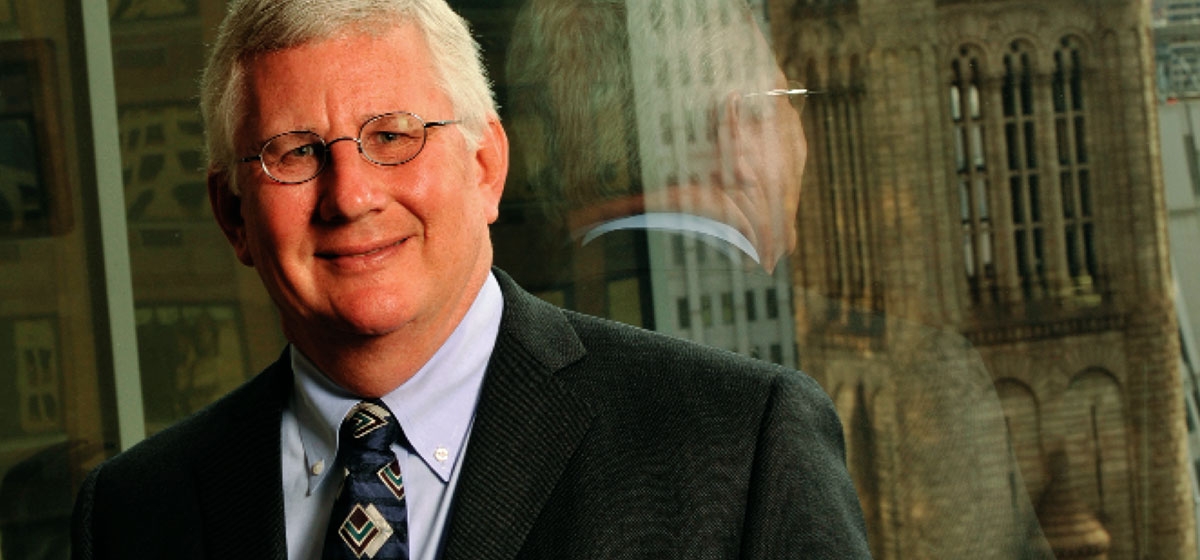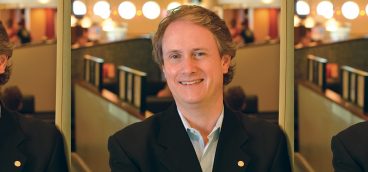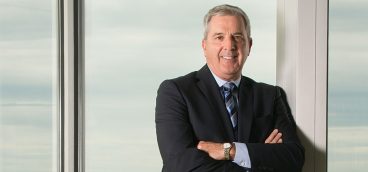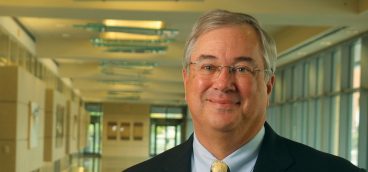The Advisor: Jack Barbour

He has a super bowl ring, a friend in the Governor’s mansion, and he’s in charge of one of the country’s biggest law firms. To boot, he’s got a dinosaur exhibit to his credit.
But for all his achievements, you won’t find Jack Barbour too close to the limelight. Which is just how he likes it. He’s a close advisor for some very important people, including Gov. Tom Corbett and Art Rooney II.
Barbour helped the Rooney family retain ownership of the team in a complex re-structuring in 2008. He has helped the Carnegie Museum revamp its dinosaur exhibit and engineered a merger to create one of the city’s biggest law firms.
Most recently, Barbour served as co-chair of Corbett’s successful gubernatorial bid and later on the governor’s transition team.
“My role was really to just observe what was going on, how Tom’s message was getting received, so that I thought the real Tom Corbett came across during the campaign,” Barbour says.
Barbour, CEO of law firm Buchanan Ingersoll & Rooney, first met Corbett in 2004, when Corbett first ran for attorney general. (Corbett won that election and retained his seat in 2008.) Barbour has been an outside advisor for Corbett, serving as sounding board and sage.
During Corbett’s successful campaign last year, Barbour offered Corbett’s campaign unvarnished opinions about how the candidate was doing. “I thought it was important that the honesty and integrity of Tom Corbett—his openness and straightforwardness—came across.”
Even after the election, Barbour was still giving the new governor an unfiltered assessment about his performance, particularly on the presentation of his budget, which generated backlash because of $1 billion in proposed cuts.
“A lot of Tom’s thoughts about the budget are very good, but I don’t think those thoughts were getting through, and I’ve told him this,” says Barbour. “I told him the reasons why he’s doing what he’s doing haven’t been getting through, and I’m hopeful that it changes.”
Corbett is the only political candidate for whom Barbour has worked. “I don’t think I’d do it for anybody else or do it again,” Barbour says. Barbour says he’s not particularly active in GOP politics but decided to help Corbett for other reasons. “It was my personal relationship with Tom. I thought he was a person of the highest integrity who would always do what he thought was the right thing. That’s why I was attracted.”
The link between large corporate law firms and state politics goes back decades, says G. Terry Madonna, a public policy professor at Franklin & Marshall University. The reason? For one, “these law firms have folks who can raise money,” Madonna says. In that respect Corbett clearly “won”—his campaign raised $24 million to Democrat Dan Onorato’s $20 million.
Another reason is the clout a man of Barbour’s stature can bring to a state-wide campaign, Madonna says. “As someone who’s been a confidant of major political and economic figures in this state, when his name gets mentioned you think ‘Here’s a guy with substance, of quality, a mover and a shaker.’”
Having a friend in the governor’s office can’t hurt Buchanan Ingersoll’s large lobbying service. But Barbour says it won’t change what the firm does; it would lobby for its many clients regardless of who won. (Barbour is quick to point out that he’s good friends with Onorato.) A commercial and real estate lawyer, Barbour admits that lobbying “may have a bad connotation” to the general public. But he says it’s an important tool for educating lawmakers on the impact of their actions.
“Our government relations folks are some of the most honest, straightforward people you’ll ever meet. The value of lobbying is getting your client’s position heard. It’s really nothing more than that.”
Thomas VanKirk, chairman of Buchanan Ingersoll & Rooney, says Barbour’s position in Corbett’s camp certainly “can’t hurt” the firm. “[Jack] clearly is going to understand and have good knowledge of people the governor selected to head up various positions in the state. It will provide us with a unique insight as to how the regulators are really thinking.”
VanKirk and Barbour negotiated the 2006 merger between Buchanan Ingersoll and Klett Rooney, where Barbour was managing partner. As the story goes, merger talks accelerated when lawyers from the two firms kibitzed during a tailgate at Super Bowl XL. “There was a fair amount of BI-Klett Rooney bonding at the Super Bowl in Detroit,” Barbour says. “That’s the story, but the reality is it was mostly done here in Pittsburgh in our offices.”
The combined firm boasted double-digit profits per partner in 2010, and as Barbour says, “The results show the merger worked out spectacularly for both firms.” Barbour, 57, lives in Adams Township, Butler Co., with his wife, Lisa, to whom he’s been married 31 years. They have four children: Andrew, 27, Meredith, 25, Lindsay, 23, and Luke, 16. What does he do for fun? “Most people laugh. I mow my own grass.” He began his legal career in the 1980s as a junior associate at a Pittsburgh law firm. Another young associate soon joined the law firm, Art Rooney II, grandson of the Pittsburgh Steelers founder, Art Rooney Sr. The two would remain friends and colleagues through the years, and when it came time for the Steelers to restructure ownership, Rooney tapped Barbour to put together a deal. The family had to sell parts of the team because several of the Rooney brothers owned interests in gambling, which the NFL prohibits. To retain a controlling interest in the team, Art II needed to buy out his uncles.
It would be among the most complicated of Barbour’s many corporate deals, involving several Rooney brothers and cousins, a slew of potential investors, and a recession.
“It was a family situation, and any time you’re dealing with the restructuring of a closely held company where a lot of different family members are involved, it’s a tricky process,” says Art Rooney II. “Not only did Jack bring his legal skills to bear, but he knew the [people involved] and was able to help us navigate through the different challenges that are involved any time you’re dealing with a family situation and the emotions that go along with that.”
According to Barbour, “There were dozens, if not hundreds of tricky parts. It was a very complicated corporate transaction. The economy collapsed in the middle of it, and we basically had to start all over because a lot of people who had money before didn’t have money afterwards. A lot of the potential investors went away or invested for much less money.”
Still, the sale went through in 2008, involving 10 separate investors, including retired coal executive Benjamin Statler, hedge fund manager David Tepper, and super Steeler John Stallworth.
If complex, it was an ultimately satisfying endeavor for Barbour, who was rewarded by the Rooneys with a Super Bowl ring after the Steelers defeated the Arizona Cardinals in Super Bowl XLIII. “I like putting deals together and getting deals to work,” says Barbour. “I like the interaction of other smart people, doing things with your clients where at the end of the day, hopefully your clients are happy, and they’ve made some money.”
The deal Barbour is proudest of didn’t involve a business or politician, but fossils and scientists. As chairman of the board for Carnegie Museum of Natural History, he helped the museum raise $33 million—including $15 million from the state—to mount “Dinosaurs in their Time,” a world-renowned exhibit showing dinosaurs in realistic habitats and settings.
“He probably devoted more time to helping the museum during those years than to helping his own law firm,” says Chris Beard, the museum’s curator of vertebrate paleontology, who became friends with Barbour during his tenure as board chairman from 2000 to 2008.
Barbour’s interest in the museum came from his childhood, which he spent on his father’s Mercer Co. tree nursery. A few times a year, the family would drive down to Pittsburgh to pick up his grandmother, who worked in the museum’s cafeteria. It remains a source of pride for Barbour, being able to retrace his grandmother’s steps into the museum as a kind of monument to what hard work can do. “From working the cafeteria to chairman of the board in three generations.”
Getting all the way to the boardroom means having a strong inner compass, Barbour says. If there’s a trick to negotiating on behalf of a client, “It’s that you’ve got to figure out where you need to go, and you’ve got to figure out where the other side needs to go. When something’s important to your client, you need to make a stand. You need to know how important it is and how big of a stand you need to make, and that depends on your clients.”
As in politics, he says, nothing in business is certain. Being a successful negotiator means living with that uncertainty.
“There’s always a doubt in anything you do. With the Steelers’ restructuring there were lots of times when there were doubts. Just like in the campaign, even though we won by 10 percentage points, we were sweating it out until even after the results were announced. You have to know where you’re going, and you have to be determined to get there.”





